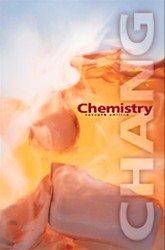|
 |  Chemistry, 7/e Raymond Chang,
Williams College
Reactions in Aqueous Solution
Internet Exercises
()
- Using Chem Finder at Cambridge Soft, http://chemfinder.camsoft.com/,
answer the following questions about sulfuric acid.
- Is sulfuric acid a strong or weak electrolyte?
- Assign oxidation numbers to all the elements in the compound.
- How would you prepare 300 mL of a 0.95 M H2SO4
solution, starting with a 8.56 M stock solution?
- How many mL of a 0.530 M NaOH solution are needed to completely neutralize
35 mL of a 0.345 M H2SO4 solution?
|
 |  |  |
()
- Review the meaning of strong and weak electrolytes at http://vax1.bemidji.msus.edu/~chemistry/acidsgen/acidsgen.html,
and then classify the following:
- citric acid
- sulfuric acid
- the smelly stuff your grandma used in a dilute solution to clean windows
- the main organic ingredient in vinegar
- the acid used by your stomach to digest your food
- the acid, containing nitrogen, used to make explosives
|
 |  |  |
()
- An acid-base titration is shown in Animation 60 at the Hardy/West site,
http://ull.chemistry.uakron.edu/genobc/.
Play the animation and then answer the following with true or false:
- The titrant is in the Erlenmeyer flask.
- The volume of the solution in the Erlenmeyer flask must be carefully
measured in order to determine the amount of acid and base in the flask.
- The point in the titration where the color changes is called the equivalence
point.
- The color changes during the titration because the compound being titrated
changes color.
- The color changes because the pH of the solution goes below 7.
|
 |  |  |
()
- Many university webpages provide tutorials on various subjects. Help on
net ionic reactions is given by Virginia Tech at this address: http://www.chem.vt.edu/RVGS/ACT/notes/.
Go to Notes_on_Net_ionic_rx+ and answer the following questions.
- In the top equation, what is oxidized?
- What is reduced?
- Which ions are spectators?
- Write the net ionic equation.
|
|
|



 2002 McGraw-Hill Higher Education
2002 McGraw-Hill Higher Education